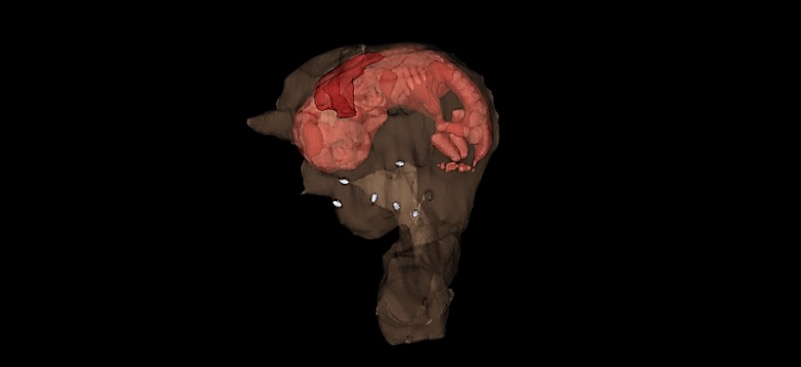Published today in the journal Nature Biotechnology, the scientists were able to show that bioengineered uteri in an animal model developed the native tissue-like structures needed to support normal reproductive function.
“The study shows that engineered uterine tissue is able to support normal pregnancies, and fetal development was normal, with offspring size and weight being comparable to those from a normal uterus,” said Anthony Atala, MD, study principal investigator and director of WFIRM. “With further development, this approach may provide a pathway to pregnancy for women with an abnormal uterus.”
WFIRM scientists are world leaders in the field of regenerative medicine and anumber of the basic principles of tissue engineering and regenerative medicine were first developed at the institute. Their strategy to bioengineer functional tissues using a patient’s own cells seeded onto biodegradable scaffolds has been effectively explored in preclinical studies and applied successfully in human patients to restore function in tubular and in hollow non-tubular organs. Regenerative medicine and tissue engineering technologies have emerged as an attractive option for overcoming donor organ shortages and other limitations of transplantation from donors. The scientists used the same bioengineering strategy to engineer the uterus, a more complex organ with higher functional requirements involving support of embryo implantation and fetal development.
For this study, rabbits were randomly assigned to four groups: (1) a tissue-engineered uteri group that received a cell-seeded scaffold using the animals’ own cells; (2) a non-seeded scaffold group, that received a polymer scaffold only; (3) a subtotal uterine excision-only control group, where the subtotal excision was repaired by suturing and (4) a normal control group, where animals underwent a sham laparotomy.
Rabbits have long been used in reproductive biology research and are ideal for uterine tissue regeneration studies as they have a relatively large uterus compared with other laboratory animals. The female rabbit’s uterus is formed by two separated, functional uterine horns and cervices, each with a capacity to carry a pregnancy.
The biodegradable polymer scaffold constructs were custom-made for each animal. The cells needed to regenerate the uterine tissue and seed the scaffolds were cultured and grown from the uterine structures of each rabbit. Six months after undergoing the scaffold implantation procedure, the rabbits were naturally mated with fertile male rabbits.
“The rabbits with cell-seeded constructs had normal pregnancies in the reconstructed segments of the uteri,” said co-author Renata S. Magalhaes, MD, PhD, BCMAS. “This research introduces new avenues for potentially creating tissue substitutes derived from a patient’s own cells to treat uterine defects.”
Uterine transplantation from deceased and living donors to patients has shown promise as a treatment for permanent uterine infertility although it requires the use of antirejection therapies.
To date, there have been about 70 uterus transplants performed worldwide. In the United States, fewer than 10 babies have been born via a transplanted uterus. This proposed strategy, creating uterine tissue with a patient’s own cells, avoids the need for a transplanted organ from a deceased or living donor, and avoids the risk of rejection and the need for antirejection drugs.
“Our results indicate that the tissue-engineered uteri responded to the expansion and mechanical strains that occur during pregnancy,” said co-author Koudy Williams, DVM. “Further preclinical studies are being planned before clinical trials are contemplated.”
This research was supported by grants from the National Institutes of Health (no. T32-EB04836-05) and the State of North Carolina. The full paper can be accessed here (hyperlinked to journal.)
Additional co-authors include: Kyung W. Yoo and James J. Yoo, both of WFIRM. Two of the scientists involved in this research are inventors on patents related to the technology, which are owned by a previous employer. There are no current or expectedfinancial interests related to these patents.
About the Wake Forest Institute for Regenerative Medicine: The Wake Forest Institute for Regenerative Medicine is recognized as an international leader in translating scientific discovery into clinical therapies, with many world firsts, including the development and implantation of the first engineered organ in a patient. Over 400 people at the institute, the largest in the world, work on more than 40 different tissues and organs. A number of the basic principles of tissue engineering and regenerative medicine were first developed at the institute. WFIRM researchers have successfully engineered replacement tissues and organs in all four categories – flat structures, tubular tissues, hollow organs and solid organs – and 15 different applications of cell/tissue therapy technologies, such as skin, urethras, cartilage, bladders, muscle, kidney, and vaginal organs, have been successfully used in human patients. The institute, which is part of Wake Forest School of Medicine, is located in the Innovation Quarter in downtown Winston-Salem, NC, and is driven by the urgent needs of patients. The institute is making a global difference in regenerative medicine through collaborations with over 400 entities and institutions worldwide, through its government, academic and industry partnerships, its start-up entities, and through major initiatives in breakthrough technologies, such as tissue engineering, cell therapies, diagnostics, drug discovery, biomanufacturing, nanotechnology, gene editing and 3D printing.
Original post https://alertarticles.info


